This was published 1 year ago
A dozen Kiwi artists descended on Arthur Boyd’s property. Here’s what came next
By Jo Higgins
If you listen carefully as you move through Bundanon Art Museum you might hear the ambient sounds of the Shoalhaven River or strains of cafe gossip. Or even chlorophyll. This is The Polyphonic Sea, an exhibition that’s brought 12 Aotearoa New Zealand-based artists to the Shoalhaven region in NSW for a lesson in listening.
This is only the fifth exhibition since the museum opened in 2022. The 1000-hectare property on which it sits, Bundanon, was gifted to the country by artists Arthur and Yvonne Boyd in 1993. The gallery was part of the artists’ long-term vision for the site, but its artist residencies began in 1994.
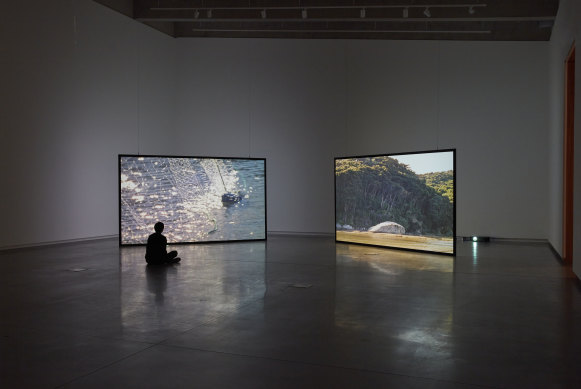
Nova Paul’s video work Nga Purakau No Nga Rakau – Stories from the Trees is part of The Polyphonic Sea at Bundanon.Credit: Zan Wimberley
“Bundanon is a place that’s known by artists; it’s long been a place of artistic production, but not of presentation, until now,” explains Sophie O’Brien, Bundanon’s Head of Curatorial and Learning and the curator of The Polyphonic Sea.
The exhibition marks Bundanon’s first international show and reiterates its commitment to supporting artists working across a range of disciplines, from sound composition to filmmaking and installation.
The artists were all invited to Bundanon for site visits and residencies where many made or adapted work in response to the site, thinking particularly about language and communication.
“We’re on the Country of the Dharawal- and Dhurga-speaking people, and we work closely with those communities, but we’re also bringing people from all over the world,” says O’Brien.
“[I was interested in] the idea of these multiple languages being spoken and that one of those languages might be the human connection to nature; the idea that we are swimming in a sea of communications.
“It was a big brief but the artists could find their own way through their own practice to come to something that made sense in the bigger context of the show.”
The works in the exhibition that are the most interesting and effective are by those artists who spent time at Bundanon, listening to the landscape through the lenses of their respective practices.
The exhibition opens with one of a pair of works by Tongan artist Sione Faletau, who is re-energising traditional Tongan weaving patterns, called kupesi, through sound. Fou ki moana / By way of the ocean is a video work and wall installation of sound waves, extracted and translated into repeating kupesi forms that are taken from audio recordings of the Shoalhaven River.
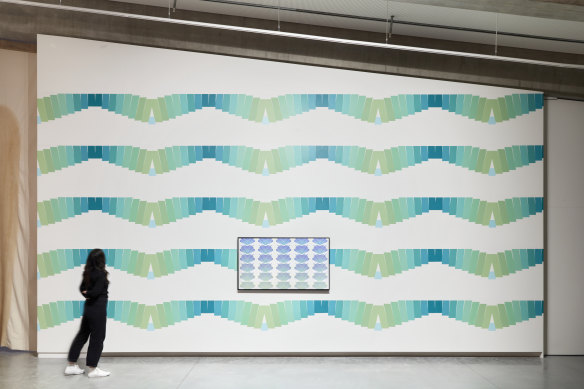
Sione Faletau’s video and wall installation Fou ki moana / By way of the ocean.Credit: Zan Wimberley
Elsewhere in the exhibition, Fonua / Embedded in the land teases out the multiple meanings of the word “fonua” that suggest ideas of protection, shelter or nourishment.
“I was drawn to the fonua, looking at the architecture of the museum being embedded into the fonua,” explains Faletau. “In Tongan, the word fonua has four different meanings: land, but also people, grave, and placenta or womb.”
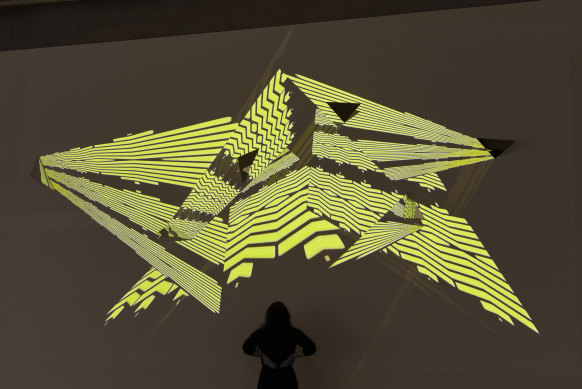
Sione Faletau’s projection Fonua / Embedded in the land.Credit: Zan Wimberley
The kupesi here are drawn from soundwaves taken from a recording of his daughter’s heartbeat, captured at a six-week pregnancy scan.
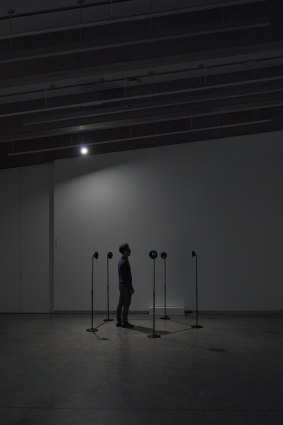
The set-up for Antonia Barnett-McIntosh’s sound work Unspoken.Credit: Zan Wimberley
Composer and sound artist Antonia Barnett-McIntosh also undertook field recordings during her residency, for her five-channel sound installation Unspoken. Here, a quintet of speakers murmur a conversational symphony: of birdsong, creaking doors and snippets of overheard gallery conversation (“we’ll go now, we’ve had a good look” / “It’s just your perfect autumn day!” / “I don’t want to go that way”). These are laced with the artist’s own recorded observations of the riverbank from the jetty.
For Sonya Lacey, an interest in ideas of invisible communication and cohabitation informed her work Chlorophyll (night vision), which was filmed in the weeks leading up to the exhibition using a modified camera that captured images on an infrared spectrum.
“It sees what we can’t see,” explains Lacey, who trained her lens on the plants and weeds where the artists’ residence meet the bush.
“I’ve been quite interested in the last little while in the physiological connections between plant and human health in terms of nutrients and a kind of reciprocity or overlap … The act of making the videos is a way to think through cohabitation.”
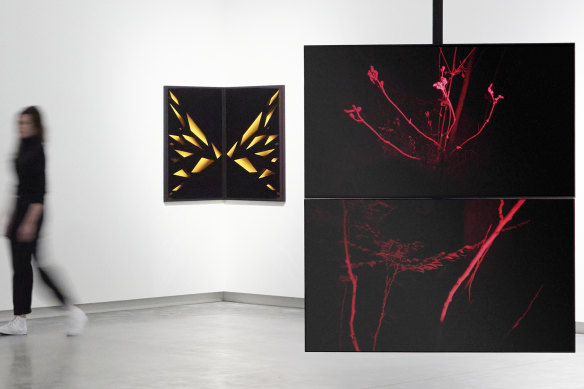
Sonya Lacey and Andrew Beck’s work seen hanging in Bundanon Art Museum.Credit: Zan Wimberley
The idea of relationships and exchange is also of deep importance to Maori artist and researcher Sarah Hudson: “Reciprocity is always a big part of my practice but it was particularly on my mind here being on someone else’s land and trying to have a light touch.”
For the last three years Hudson has been researching and learning about customary Maori paint-making processes and earth pigments. On her site visit to Bundanon in April, Hudson connected with local First Nations custodians to learn about their cultural practices, particularly when it comes to ochre.
“I was apprehensive about showing works about earth pigments here; to come out to the lands of people who have unbroken practice working with earth pigments. It’s very intimidating and I also wanted to be humble, in a place where I’m not from – bringing my practice onto someone else’s land is a means to build relationships. That’s why the residency was really great.”
Hudson’s work The hill inside is a pair of visually beautiful, meditative video works that explore rocks, soil and clay and the symbiotic relationship between rocks and water. The first video was originally commissioned by Auckland Pride, but its companion piece was inspired by the significance of the Shoalhaven River to Bundanon and was made after Hudson returned to Aotearoa.

Sarah Hudson’s video installation The hill inside.Credit: Zan Wimberley
Draped canvas “portals” enclose the space where the videos are shown side by side, and another large canvas is installed overhead, all painted with earth pigments made from the rocks and topsoil above the museum.
“I wasn’t comfortable bringing ochres from Aotearoa. The idea of shifting and selling land, which our material is, is very loaded for me,” says Hudson. “I’m also not going to tap into the ochre sources here because it’s also not my place. So what I chose to use was the topsoil off the hill that the gallery is within, which is another acknowledgment of place.
“The hill has been altered to fit the gallery inside and I’m taking that hill and shifting its presence inside – as if this place doesn’t have enough presence – but just to highlight the importance of place within a show that talks about language.”
It is these kinds of reflections and site-responsive works that really illustrate what a gift Bundanon is for artists.
“Arthur really thought of Bundanon as a place where we didn’t just learn about art, but what artists are – what they can achieve, how they work,” says O’Brien. “He was a very great believer that this place could generate so many new thoughts in a creative field.”
The Polyphonic Sea is at Bundanon Art Museum until October 8.
The writer and editor of this story both stayed onsite as guests of Bundanon.
Find out the next TV, streaming series and movies to add to your must-sees. Get The Watchlist delivered every Thursday.